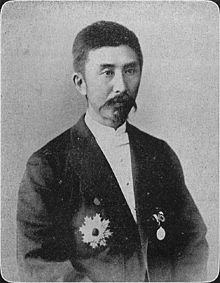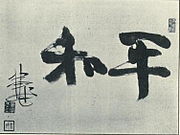- Ōura Kanetake
-
Ōura Kanetake
大浦兼武
Ōura in 1898Born June 15, 1850
Kagoshima, Satsuma Domain, JapanDied September 30, 1918 (aged 68) Nationality Japanese Occupation politician, cabinet minister Known for "Ōura scandal" In this Japanese name, the family name is "Ōura".Ōura Kanetake (大浦 兼武, June 15, 1850 – September 30 1918) was a politician and bureaucrat in late Meiji and early Taishō period Empire of Japan. In 1907, he was raised to the rank and title of danshaku (baron) under the kazoku peerage system.[1]
Contents
Early life
The Ōura family were hereditary retainers to a branch of the Shimazu clan of Satsuma Domain. As a Satsuma samurai, Ōura Kanetaka participated in the Boshin War and the suppression of the Ōuetsu Reppan Dōmei during the Meiji Restoration. Under the new Meiji government, he joined the fledgling Japanese police force, working his way up through the ranks until he became Assistant Police Inspector of the Tokyo Metropolitan Police Department. In this capacity, he was field commander of the police forces sent to assist the fledgling Imperial Japanese Army in suppressing his fellow Satsuma countrymen in the Satsuma Rebellion.
Political career
After serving as appointed governor of Shimane Prefecture (1893-1895), Yamaguchi Prefecture (1895-1896), Kumamoto Prefecture (1896-1898) and Miyazaki Prefecture (1898), Ōura was appointed Superintendent General of the Police, and was given a seat in the House of Peers of the Diet of Japan. In 1903, under the 1st Katsura administration, he became Minister of Communications. He then served as Minister of Agriculture and Commerce under the 2nd Katsura cabinet and was also chairman of the Japanese committee organizing the Japan–British Exhibition.[2] He subsequently served as Home Minister under the 3rd Katsura cabinet, and as both Minister of Agriculture and Trade and Home Minister under the 2nd Ōkuma administration.
Ōura scandal
While in the Ōkuma administration, he was accused of perpetrating voting fraud in the Diet by bribing minor political party and undecided members to influence passage of a military spending bill introduced by Ōkuma. This incident came to be known as the Ōura scandal; he was forced to retire, and eventually the Ōkuma administration itself was brought down.
Later life
In his final years, Ōura served as chairman of the Dai Nippon Butoku Kai.
Ōura died in 1918 at the age of 68.
Notes
References
- Idditti, Smimasa. Life of Marquis Shigenobu Okuma: A Maker of New Japan. Kegan Paul International Ltd. (2006). ISBN 0-7103-1186-9
- Idditti, Junesay. Marquis Shigenobu Okuma - A Biographical Study in the Rise of Democratic Japan. Hokuseido Press (1956). ASIN: B000IPQ4VQ
- Lebra-Chapman, Joyce. Okuma Shigenobu: statesman of Meiji Japan. Australian National University Press (1973). ISBN 0-7081-0400-2
- Mochizuki, Kotarō. (1910) Japan To-day. A Souvenir of the Anglo-Japanese Exhibition held in London, 1910. Tokyo: Liberal News Agency. OCLC 5327867
- Oka Yoshitake, et al. Five Political Leaders of Modern Japan: Ito Hirobumi, Okuma Shigenobu, Hara Takashi, Inukai Tsuyoshi, and Saionji Kimmochi. University of Tokyo Press (1984). ISBN 0-86008-379-9
- Sims, Richard (2001). Japanese Political History Since the Meiji Renovation 1868-2000. Palgrave Macmillan. ISBN 0-312-23915-7.
Preceded by
Sone ArasukeMinister of Communications
Sept 1903-Jan 1906Succeeded by
Yamagata IsaburoPreceded by
Matsuoka YasukoMinister of Agriculture & Commerce
Jul 1908-Aug 1911Succeeded by
Makino NobuakiPreceded by
Hara TakashiHome Minister
Dec 1912 - Feb 1913Succeeded by
Hara TakashiPreceded by
Yamamoto TatsuoMinister of Agriculture & Commerce
Apr 1914 - Jan 1915Succeeded by
Kōno HironakaPreceded by
Ōkuma ShigenobuHome Minister
Jan 1915 - Jul 1915Succeeded by
Ōkuma ShigenobuCategories:- 1850 births
- 1918 deaths
- People from Kagoshima Prefecture
- Shimazu retainers
- People of the Boshin War
- People in Meiji period Japan
- Government ministers of Japan
- Members of the House of Peers (Japan)
- Kazoku
- Ministers of Home Affairs of Japan
Wikimedia Foundation. 2010.

